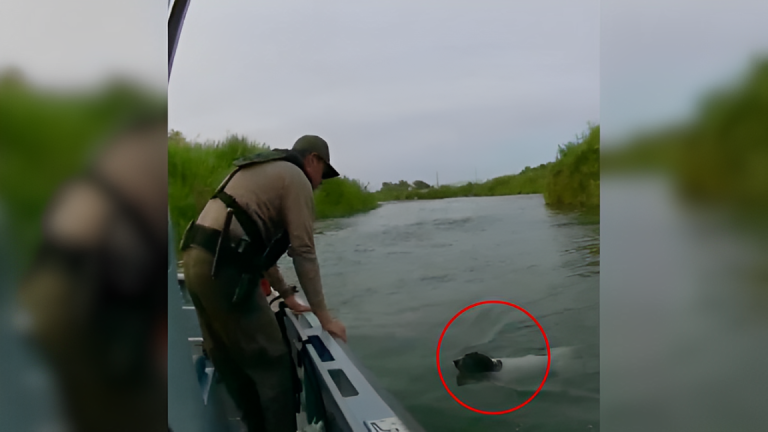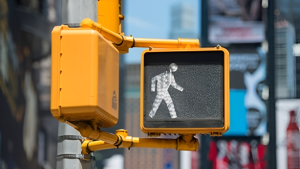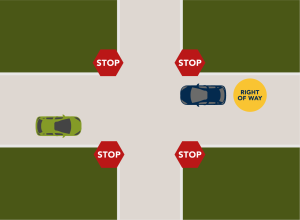Indiana’s right of way laws are important rules that help ensure safe traffic flow on the state’s roads. These laws determine which driver, pedestrian, or cyclist has the right to go first in certain situations. Understanding these rules can prevent accidents, reduce confusion, and make travel safer for everyone. Whether you are a seasoned driver or just starting, knowing when to yield or who goes first is essential for keeping roads safe in Indiana.
In this article, we will take a deep dive into Indiana’s right of way laws, break them down by different driving situations, and offer practical advice on how to follow them. Let’s explore when you should yield, stop, or let someone else go first to avoid accidents and penalties.
What is Right of Way?
The right of way is a traffic rule that indicates which vehicle, pedestrian, or cyclist has the priority to go first in certain situations. It’s not always about who’s driving the fastest or who has the best position; it’s about understanding the rules for yielding to others. When a driver yields the right of way, they allow other road users to go first to ensure smooth traffic flow and prevent accidents.
While right of way rules are critical for safety, they also help make driving more predictable. For example, knowing that a car on your right at an intersection has the right of way can help you avoid confusion and improve overall traffic safety.
Common Right of Way Scenarios in Indiana
Here are the main scenarios where Indiana drivers need to know the right of way rules:
1. At Intersections Without Traffic Signals or Signs
When approaching an intersection without a stop sign, yield sign, or traffic light, Indiana law states that drivers must yield to any vehicles coming from the right. This is called the right-hand rule.
- If two vehicles reach the intersection at the same time, the driver on the right has the right of way.
- If you are on the left side, you must yield to the vehicle on the right.
This simple rule prevents confusion at intersections without any signals or signs.
2. At Stop Signs
When you encounter a stop sign, Indiana law requires you to come to a full stop at the stop line, crosswalk, or intersection. After stopping, you need to look carefully and yield to any pedestrians, cyclists, or vehicles before proceeding.
- If two vehicles arrive at a stop sign simultaneously, the vehicle on the right has the right of way.
- If you are turning left at the intersection, you must yield to oncoming traffic before completing the turn.
Failure to stop completely or yield when required can result in fines or accidents.
3. At Traffic Lights
When driving through an intersection controlled by traffic lights, Indiana drivers need to understand the rules for each light:
- Green light: You can go, but you must always yield to pedestrians crossing the street.
- Yellow light: If you can safely stop before the intersection, do so. If stopping is not possible, proceed carefully.
- Red light: You must stop and wait for the next green light. If you are turning left or right, you must yield to other vehicles or pedestrians before turning.
Keep in mind that even with a green light, you still need to yield to pedestrians or other vehicles when required.
4. Pedestrian Crosswalks
Indiana law gives pedestrians the right of way at crosswalks, whether they are marked or unmarked. Drivers must yield to pedestrians crossing the road at crosswalks, whether or not there is a traffic signal.
- If a pedestrian is crossing at a crosswalk or waiting to cross, you must stop and let them pass safely.
- If you fail to stop for pedestrians, you could be fined or even be held liable for causing harm.
Always be extra cautious around crosswalks, especially near schools, parks, or shopping centers, where pedestrians may be crossing frequently.
5. School Buses
When a school bus has its red lights flashing and stop arm extended, you must stop, regardless of whether you are traveling in the same or opposite direction. This law is meant to protect children as they get on or off the bus.
- Stop at least 20 feet away from a school bus with flashing red lights.
- Never pass a school bus when its stop arm is out, even if you are on the opposite side of a divided road.
Failure to stop for a school bus with flashing lights can result in heavy fines and points on your driving record.
6. Emergency Vehicles
When an emergency vehicle (such as a police car, ambulance, or fire truck) approaches with flashing lights and sirens, you must yield the right of way. Indiana law requires drivers to pull over to the right side of the road to allow emergency vehicles to pass safely.
- If you are driving in the same direction as an emergency vehicle, move to the right and stop.
- If you are traveling in the opposite direction on a road with more than one lane, you must also stop and allow the emergency vehicle to pass.
If there is no space to move over, simply slow down and stay alert until the emergency vehicle has passed.
7. Merging onto a Highway
When merging onto a highway, vehicles already on the highway have the right of way. It is your responsibility to adjust your speed to match the flow of traffic and yield to any vehicles already on the road.
- Do not force your way into traffic; instead, wait for a safe gap and merge when possible.
- Always check for any vehicles in your blind spot before merging.
Proper merging is essential for maintaining smooth traffic flow and avoiding accidents.
8. Roundabouts
Roundabouts are becoming more common in Indiana as they help improve traffic flow. In a roundabout, vehicles already inside the roundabout have the right of way. Drivers entering the roundabout must yield to traffic already circulating.
- Always signal your turn when exiting a roundabout.
- Be aware of pedestrians who may be crossing at roundabout exits.
Roundabouts help reduce accidents by reducing the chances of head-on collisions, so it’s important to follow the right of way rules closely.
9. Bicyclists and Cyclists
In Indiana, bicyclists and cyclists have the same rights as drivers. When sharing the road with cyclists, drivers need to be aware and yield when required.
- Always yield to cyclists when they are in bike lanes or when you are turning at intersections.
- When passing cyclists, maintain a safe distance of at least 3 feet.
Be mindful of cyclists on the road, as they are more vulnerable than other road users.
Key Tips for Drivers in Indiana
- Yield When Required: Don’t hesitate to yield the right of way when needed. It’s safer for everyone.
- Always Stop at Stop Signs: Complete your stop at stop signs, look both ways, and proceed with caution.
- Watch for Pedestrians: Yield to pedestrians at crosswalks, and be especially careful around schools or high-traffic areas.
- Obey School Bus Rules: Never pass a school bus with flashing red lights, even on a divided road.
- Move Over for Emergency Vehicles: Always pull over to the right when you see emergency vehicles approaching.
- Drive Defensively: Always be aware of other drivers, cyclists, and pedestrians to prevent accidents.
Conclusion
By understanding and following Indiana’s right of way laws, drivers can help make the roads safer for everyone. These laws are in place to prevent accidents, ensure smoother traffic flow, and protect pedestrians and cyclists. It’s important to remember that when in doubt, it’s always better to yield and be cautious rather than risking an accident or penalty. Stay safe on the roads by obeying these rules, and encourage others to do the same.
Disclaimer – Our editorial team has thoroughly fact-checked this article to ensure its accuracy and eliminate any potential misinformation. We are dedicated to upholding the highest standards of integrity in our content.

























+ There are no comments
Add yours